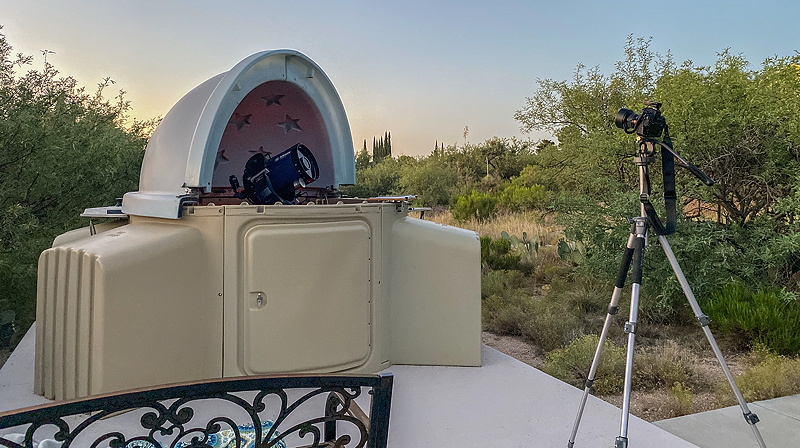Moon on Dome with Explore Scientific 14mm 100° eyepiece & ISS
Posted: 4 June 2020
Friday afternoon, 29 May 2020, the sky became overcast, with thundershowers in the area. Cloudy skies continued for several days but there was not much rain at Cassiopeia Observatory: 30 May 0.03", 31 May 0.01". Monday afternoon, 1 June, there was some mammatus cloud structure over the observatory.

Cloudy skies continued until Wednesday, 3 June.
|
Open: Wednesday, 3 June 2020, 1900 MST Temperature: 93°F |
Session: 1488 Conditions: Clear |
Equipment:
12" f/8 LX600 w/StarLock
2" 24mm UWA eyepiece
2" 14mm 100° eyepiece
Camera:
D850 DSLR
1906 MST: LX600 ON, StarLock OFF, High Precision OFF.
Slewed the 12" telescope to the waxing gibbous Moon which was still behind a tree.
Viewed the Moon through tree branches, 102X. Set tracking rate to "Lunar".
1914 MST: relaxed on the observatory patio bench while waiting for the Moon to rise above the tree.
1930 MST: sunset.
Viewed the Moon now clear of the tree, 102X.
Mounted the D850 DSLR at prime focus + focal reducer. The Moon (1/320sec, ISO 100).

1943 MST: viewed the Moon, 174X. Entire disk was visible.
I set up the D850 DSLR with a 14mm UWA lens on the observatory patio.

1952 MST: relaxed on the bench.
2001 MST: began preparing for a pass of the International Space Station. It would be low in the northern sky against a still bright twilight sky. I projected the Moon onto the observatory dome using the Explore Scientific 2" 14mm 100° eyepiece (174X). I positioned the camera to get the best view of the dome, Moon, and ISS during its pass.
Moon on Dome with ISS (f/8, 30 seconds, ISO 500, 14mm UWA).

Click or tap on image for larger version
After the ISS pass ended I re-positioned the D850 DSLR for this photograph of the Moon on the Dome (f/8, 30 seconds, ISO 800, 14mm UWA). The constellation of Lyra can be seen just to the right of the dome.

Click or tap on image for larger version
I have previously imaged the Moon on the Dome, but I always used a Meade 2" 24mm UWA eyepiece (102X) or an OPT 2" 30mm eyepiece (81X) to provide a bright low magnification projection. With the bright wide field-of-view of the Explore Scientific 2" 14mm 100° eyepiece I decided to give it a try. I am happy with this higher magnification (i.e., larger projected image of the Moon) photograph.
Took a final look at the Moon, 102X.
2047 MST: LX600 OFF.
|
Close: Wednesday, 3 June 2020, 2057 MST Temperature: 82°F |
Session Length: 1h 57m Conditions: Clear |
On my previous report I mentioned that I participated in an IDA Dark Sky Advocates video teleconference from the observatory. Here is what they saw.

I have submitted my reviews of the Bresser Smartphone Adapter and the Explore Scientific 2" 14mm 100° and 2" 5.5mm 100° eyepieces to Astronomy Technology Today. Once they are published in the magazine I will post my reviews on the Cassiopeia Observatory Reviews page.
Comments are welcome using Email. Twitter users can use the button below to tweet this report to their followers. Thanks.
Cassiopeia Observatory Home Page
Copyright ©2020 Michael L. Weasner / mweasner@me.com
URL = http://www.weasner.com/co/Reports/2020/06/04/index.html
